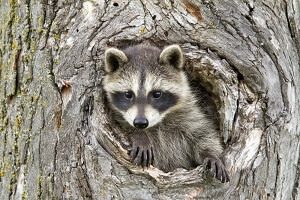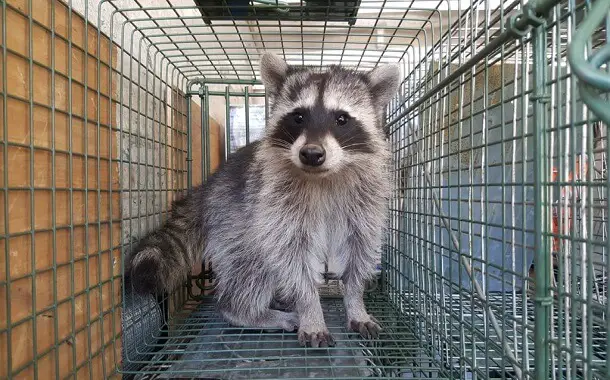Raccoon Removal Costs
Last Updated on December 27, 2023
Written by CPA Alec Pow | Content Reviewed by ![]() CFA Alexander Popinker
CFA Alexander Popinker
Professional raccoon removal services can help you get rid of raccoon problems in and around your home. If you’re thinking of doing the job yourself, keep in mind that removing any critters, including raccoons, will require special training and techniques that will ensure the safe and effective capturing and relocation of the wild animal. This is due to the complex nature of wildlife rules and regulations. The actual cost of removal services will be impacted by a lot of factors, like the severity of the infestation and the actual pest you will be dealing with.
It will usually cost less to remove living animals than ones that aren’t alive anymore, especially if they are found inside the walls or other areas that are hard to reach. Among the usual pets, raccoons might be among the more expensive ones to remove mainly because they will be a lot more difficult to trap and take away from a property due to their size. The final cost will also be affected by the number of visits the professional will have to take in order to place and reset the traps.
You might also like our articles on the cost of removing bats, bees, or fleas from around your house.
Let’s go over some numbers for raccoon removal, including the needed inspection beforehand and the post-removal cleaning and preventive services.
| Item | Unit Cost |
| Initial inspection | $100-$150 per inspection |
| Live trap | $100-$130 per trap/raccoon |
| Removal of dead raccoons | $300-$340 per animal |
| Removal of nests | $550 per nest |
| Any damage repair: HVAC systems, insulation, drywall, etc. | $120-$1,200 per repair |
| Professional cleanup and sanitization | $550 per service |
| Exclusion barrier installation | $15-$30 per linear foot |
| Total Cost | $1,735-$2,850 |
Additional Costs and Other Aspects
Raccoons aren’t the cleanest creatures and are known to be infested with ticks and fleas, but also to carry a lot of diseases and other parasites. This is why professional clean-up after each raccoon removal would be very much recommended, although its costs are in no way small.
There are companies and contractors that will work on a per visit fee instead of a per-service one. Depending on the work needed to be done, these fees will be as high as the initial inspection fee, or sometimes even higher.
 There are companies that won’t do any cleanup or remediation and will only stick to handling the removal of raccoons and other pests. If you want to save on the final cost, you should try to find a company that either does the clean-up itself or works with a pest control service to remove all the elements of the infestation. In this way, you will usually pay just one rate for these services combined.
There are companies that won’t do any cleanup or remediation and will only stick to handling the removal of raccoons and other pests. If you want to save on the final cost, you should try to find a company that either does the clean-up itself or works with a pest control service to remove all the elements of the infestation. In this way, you will usually pay just one rate for these services combined.
Your home insurance policy might even cover some of the repairs you will need to do after successful removal. Talk to your insurance provider before you decide to pay for these yourself.
When it comes to living animals, the service should take care of their safe relocation. It is illegal to try to poison or harm in any way live and healthy raccoons and exterminators should never try to harm the animals while trying to remove them. You will always be charged more for the extermination of a live animal because the process is more complicated.
DIY considerations
Check out your state’s laws because there are some places in which trapping raccoons using home traps or lethal traps is illegal. You should really consider employing professionals to do this job but if you think you’re up to it, you should at least check with animal control to make sure what you’re doing is legal.
You can find all kinds of deterrents and repellents at home improvement stores and DIY retailers, but keep in mind that raccoons are very resilient creatures, making these techniques very ineffective.
Tips when trying to catch a raccoon in a trap
Trap Placement
As I said before, even before actually getting a trap, check with your state legislature for any laws against trapping of small animals like raccoons. Keep in mind that these creatures will build dens and shepters in all kinds of places all around a home, like in tree hallows in yards, in walls, attics, and even in chimneys. This means that you will have to place any traps in areas where raccoon activity is more likely. The more traps you will place in areas frequented by these wild animals, the better results you will get.
2. Baiting the Raccoon Trap
When you want to attract a raccoon into a trap you just placed, there are a few different baits you can pick between. You shouldn’t pick a type of meat as bait because this can usually attract other animals as well, like home cats or dogs. Aside from this, raccoons will eat basically anything but some alternative foods you should consider are bread or marshmallows. You can also use baits of commercial type along with home-made ones.
3. Setting the Trap
Raccoons can easily become wary of traps especially ones that are always placed into the same place, because they have a great memory and are also very smart. Before actually setting the trap you can even leave it open with bait inside so that the animal can get acquainted to it. You should then set the door or doors carefully to the open position. Although most traps are different one from another, they also come with instructions on how to be used. Once you’re sure you’ve set it properly, you should test the trigger and closing mechanism. To do this you will have to press on the trigger place. Keep in mind that any raccoon trap should be anchored properly so that the animal won’t run away with it.


Leave a Reply
Want to join the discussion?Feel free to contribute!